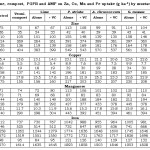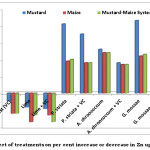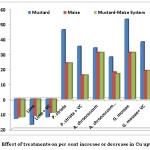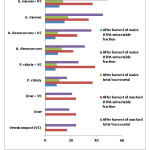Introduction
Trace metals are ubiquitous in the environment and present in small amounts in normal condition. Contamination of trace metals refers to their anthropogenic accumulation, which may or may not inflict any harm to the system or organism. Pollution is the worst example of contamination where irreversible toxicity-damage has already occurred due to buildup of the toxic substances in the system.1 Anthropogenic sources of trace elements are a consequence of industrial development and urbanization. These sources are related to human activities such as mining and smelter activities, fossil fuel combustion, waste incineration and disposal, agricultural practices like use of fertilizers and pesticides.2 Soil is the key component of natural ecosystems because environmental sustainability depends largely on a sustainable ecosystem. Unlike other environmental components, pollutants have long residence time in soil. Therefore, soil acts as a sink or a filter in which pollutants are accumulated rapidly but depleted slowly. Jharkhand has several coal mines. The Damodar river basin is a repository of approximately 46 per cent of the Indian coal reserves. Due to extensive coal mining and rapid growth of industries, soil and water resources have been badly contaminated. Besides mining, coal based industries like coal washeries, coke oven plant, coal fired thermal power plant, steel plants and other related industries in the region are responsible for degradation of environmental quality. Hence, the present investigation was planned to study the effect of amendments and microbial inoculants on micronutrient removal by mustard-maize cropping system in trace metal contaminated soil.
 |
Table 1: Effect of lime, compost, PGPR and AMF on Zn, Cu, Mn and Fe uptake (g ha-1) by mustard and maize. Click here to View table |
Table 2: Effect of lime, compost, PGPR and AMF on total Zn, Cu, Mn and Fe removal (g ha-1) by mustard and maize.
| Treatments |
Zn |
Cu |
Mn |
Fe |
|
| Control |
471 |
178 |
483 |
2928 |
|
| Vermicompost |
415 |
157 |
435 |
2876 |
|
| Lime | Alone |
393 |
158 |
438 |
2879 |
| With VC |
409 |
162 |
453 |
2924 |
|
| Pseudomonas striata | Alone |
565 |
220 |
643 |
3667 |
| With VC |
558 |
206 |
580 |
3493 |
|
| Azotobacter chroococcum | Alone |
584 |
233 |
635 |
3551 |
| With VC |
550 |
209 |
576 |
3446 |
|
| Glomus mossae | Alone |
577 |
233 |
673 |
3698 |
| With VC |
553 |
211 |
588 |
3475 |
|
| S Em + |
8.5 |
3.5 |
9.0 |
56.4 |
|
| CD (P = 0.05) |
25.4 |
10.4 |
26.8 |
167.5 |
|
| CV % |
12.7 |
12.6 |
9.9 |
13.3 |
|
Table 3: Effect of treatments on micronutrient status (mg kg-1) of soil after harvest of mustard and maize.
| Treatments |
Mustard |
Maize |
||
|
Without VC |
With VC |
Without VC |
With VC |
|
|
Zn |
||||
| Control (RDF) |
35.42 (2.57) |
35.33 (2.14) |
28.67 (2.14) |
28.50 (1.62) |
| Lime |
35.42 (1.96) |
35.42 (1.96) |
28.58 (1.74) |
28.50 (1.69) |
| P. striata |
32.25 (1.63) |
32.75 (1.57) |
25.50 (1.77) |
26.00 (1.58) |
| A. chroococcum |
31.75 (2.01) |
32.58 (1.93) |
25.00 (1.48) |
25.83 (1.37) |
| G. mossae |
30.17 (1.69) |
31.42 (1.63) |
23.42 (1.18) |
24.67 (1.10) |
| SEm+ |
0.32 (0.09) |
0.36 (0.09) |
||
| CD (P=0.05) |
0.95 (0.27) |
1.08 (0.26) |
||
| CV % |
9.59 (11.23) |
12.25 (12.01) |
||
|
Cu |
||||
| Control (RDF) |
46.58 (1.60) |
46.17 (1.25) |
39.25 (1.41) |
38.67 (1.18) |
| Lime |
46.25 (1.29) |
46.17 (1.24) |
38.75 (1.17) |
38.67 (1.17) |
| P. striata |
40.58 (1.10) |
43.17 (1.07) |
33.08 (1.14) |
35.67 (1.11) |
| A. chroococcum |
41.50 (1.19) |
43.83 (1.17) |
34.00 (1.19) |
36.33 (1.13) |
| G. mossae |
38.33 (0.95) |
41.92 (0.92) |
30.83 (0.93) |
34.42 (0.89) |
| SEm+ |
0.38 (0.03) |
0.43 (0.03) |
||
| CD (P=0.05) |
1.12 (0.09) |
1.26 (0.09) |
||
| CV % |
9.90 (4.67) |
12.28 (5.09) |
||
|
Mn |
||||
| Control (RDF) |
325 (20.11) |
320 (17.43) |
307 (19.16) |
304 (15.35) |
| Lime |
321 (17.76) |
323 (17.60) |
305 (15.01) |
306 (15.23) |
| P. striata |
297 (15.55) |
301 (16.16) |
278 (13.90) |
281 (14.64) |
| A. chroococcum |
296 (16.01) |
315 (16.28) |
282 (14.34) |
284 (14.83) |
| G. mossae |
292 (15.05) |
297 (15.88) |
252 (12.17) |
273 (12.59) |
| SEm+ |
1.36 (0.31) |
1.40 (0.22) |
||
| CD (P=0.05) |
4.05 (0.91) |
4.15 (0.66) |
||
| CV % |
13.44 (12.97) |
14.28 (10.08) |
||
|
Fe |
||||
| Control (RDF) |
19130 (40.39) |
19040 (34.73) |
18525 (36.48) |
18442 (30.90) |
| Lime |
19057 (34.15) |
19062 (34.67) |
18463 (30.32) |
18477 (30.51) |
| P. striata |
18738 (32.61) |
18790 (33.61) |
18142 (28.45) |
18222 (29.45) |
| A. chroococcum |
18547 (32.31) |
18603 (33.11) |
17952 (28.15) |
18023 (28.95) |
| G. mossae |
18258 (30.79) |
18312 (32.00) |
17647 (26.63) |
17727 (27.63) |
| SEm+ |
10.12 (0.42) |
11.10 (0.40) |
||
| CD (P=0.05) |
30.07 (1.24) |
32.99 (1.18) |
||
| CV % |
12.80 (12.39) |
14.27 (12.61) |
||
*Data in parenthesis indicate DTPA-extractable values
Materials and Methods
An experiment was conducted in farmer’s field during rabi season in 2009-10 and kharif season in 2010 at Patratu (Ramgarh) to investigate the effect of lime, compost, plant growth promoting rhizobacteria and arbuscular mycorrhizal fungi on removal of micronutrients including Zn, Cu, Mn and Fe by mustard and maize in trace metal contaminated soil. The soil was sandy loam in texture with pH 6.08, EC 0.07 dS m-1, organic carbon 2.85 g kg-1, DTPA-extractable Zn 3.05, Cu 1.46, Mn 20.53 and Fe 39.62 mg kg-1, Total Zn 37.75, Cu 48.32, Mn 344 and Fe 19457 mg kg-1. Mustard (cv. T 59) and maize (cv. PEHM 2) were grown in sequence at the same site with 10 treatments in randomized block design with three replications. The plant samples were collected at harvest of the crop, washed with double distilled water, oven dried and digested in mixture of HNO3:HClO4 in the ratio of 9:4 at 800C until a transparent solution was obtained.3 The transparent solution was diluted with double distilled water and filtered. The micronutrient content in plant parts was determined on Atomic Absorption Spectrophotometer (EICL AAS4139) by employing the appropriate hollow cathode lamp. Micronutrient status of soil after harvest of both crops was determined by extracting soil with DTPA (0.005M DTPA, 0.01M CaCl2, 0.1M TEA), pH adjusted to 7.3 with the help of dilute HCl, maintaining 1:2 soil to extractant ratio and shaking for 2 hrs at 120 rpm.4
 |
Figure 1: Effect of treatments on per cent increase or decrease in Zn uptake. Click here to View figure |
 |
Figure 2: Effect of treatments on per cent increase or decrease in Cu uptake Click here to View figure |
 |
Figure 3: Per cent reduction in zinc content after harvest of crops. Click here to View figure |
Results and Discussion
Micronutrient removal by mustard and maize
Removal of Zn, Cu, Mn and Fe by mustard, maize and mustard-maize system as presented in table 1 and 2. Inoculation of Glomus mossae resulted in significantly higher removal of Zn by mustard stover (114 g ha-1), grain (44 g ha-1), mustard (158 g ha-1) and maize straw (397 g ha-1). However, Zn removal by maize grain (181 g ha-1), maize (570 g ha-1) and mustard-maize system (584 g ha-1) was observed with Azotobacter chroococcum inoculation. The differences observed among three microbial inoculants were not significant. Application of vermicompost alone or in combination with lime and microbial inoculants resulted in reduction of Zn uptake. However, significant reduction in Zn removal by crops was observed when lime was applied either alone or in combination with vermicompost. Per cent increase or decrease in Zn removal by crops is presented in fig 1. The extent of decrease in Zn uptake by vermicompost, lime and their combination was 5 to 12, 8 to 17 and 9 to 17 per cent over control. However, increase in Zn uptake from 22 to 43, 19 to 41 and 24 to 26 per cent as compared to control was observed under G. mossae, P. striata and A. chroococcum inoculation. Copper uptake followed almost similar trend as that of Zn. Cu uptake by mustard stover + grain (34 g ha-1) and maize straw (207 g ha-1) was higher under G. mossae inoculation while Cu uptake by maize straw + grain (230 g ha-1) and mustard-maize system (233 g ha-1) was higher under A. chroococcum inoculation. Reduction in Cu removal by crops with vermicompost, lime and their combination was noticed (9 to 17 per cent over control). It was also observed that when vermicompost was applied with microbial inoculants this resulted in decreased Cu uptake as compared to microbial inoculants alone (Fig 2). Similar trend in Mn and Fe uptake by mustard-maize cropping system was noticed. Glomus mossae inoculation resulted in significantly higher Mn removal by mustard (212 g ha-1), maize (461 g ha-1) and mustard-maize system (673 g ha-1). However, Mn removal by crops with G. mossae, P. striata and A. chroococcum inoculation were statistically at par. Vermicompost application alone or with microbial inoculants and lime decreased the Mn removal to some extent. Higher Fe uptake by mustard was recorded with P. striata, while G. mossae recorded the high Fe uptake by maize and mustard-maize system. Reduction in Fe uptake was also observed with vermicompost, lime and their combination. Increase in micronutrient removal by plant growth promoting rhizobacteria (Pseudomonas striata and Azotobacter chroococcum) might be due to their ability to produce siderophores that chelate cations and make available to the plant root. Leung5 reported the increased Zn and Cu uptake by Pseudomonas pseudoalcaligenes. Gamalero6 found that Pseudomonas fluorescence increased the micronutrient removal by tomato and cucumber in heavy metal contaminated soil. Jeffries7 reported that arbuscular mycorrhizal fungi (Glomus mossae) form a unique structure called abuscules vesicules that help plant to capture nutrients from soil. Significant increase in Zn content in clover roots without affecting the shoot concentration by mixed population of AMF was reported by Tonin.8 Weng9 observed increased accumulation of Zn and Cu by Elsholiza splendens inoculated with AMF. Reduction in micronutrient removal particularly Zn and Cu with vermicompost and lime might be due to their adsorption. Similar results were observed by Pierzynski and Schwab,10 Bolan11 and Rattan.1
Micronutrient status of soil after harvest of mustard and maize
Results presented in table 3 indicate total and available micronutrients of soil after harvest of mustard and maize. It was observed that microbial inoculations reduced the total Zn in soil to the extent of 8 to 15 per cent as compared to control. The lowest total Zn after harvest of mustard (30.17 mg kg-1) and maize (23.42 mg kg-1) was found with Glomus mossae inoculation which was at par with other two microbial inoculants. However, DTPA-Zn was significantly reduced by microbial inoculation and amendments. The extent of reduction was 17 to 49 per cent over control for microbial inoculants and the corresponding value was 17 to 24 per cent for amendments (Fig 4.19). Total Cu, Mn and Fe followed similar trend of reduction in content by microbial inoculations and the extent was 6 to 21, 3 to 18 and 2 to 5 per cent, respectively over control. Glomus mossae was the most efficient strain in reducing the total content; however, no significant influence of amendments on total metal content was noticed after harvest of both crops. Application of vermicompost, lime, lime + vermicompost and microbial inoculations resulted in significant reduction in DTPA-Cu, Mn and Fe after harvest of crops and the extent was 16 to 43, 19 to 36 and 18 to 27 per cent for microbial inoculations and 16 to 22, 12 to 22 and 14 to17 for amendments. It was noticed that microbial inoculation along with vermicompost resulted in further reduction of DTPA extractable micronutrients in soil. Pseudomonas striata and Azotobacter chroococcum have ability to produce siderophores which chelate cations and make available to the plant roots. This might be the possible reason for increased micronutrient uptake by crops, resulting in reduced total and available content in soil. The results are in conformity with [5] [6]. Formation of abuscules vesicules by Glomus mossae, that help plant to capture nutrients from soil might had increased the micronutrient uptake thereby reduction in content.7,12,9 Reduction in available micronutrient content by amendments might be due to their adsorption, complexation or precipitation. Similar results were observed by Pierzynski and Schwab,10 Bolan11 and Rattan.1
Conclusion
On the basis of present investigation it can be concluded that microbial inoculation resulted in increased micronutrients removal by mustard, maize and system. However, amendments (vermicompost, lime and their combination) reduced the removal by the crops. Reduction in total micronutrients content in soil after harvest of crops was recorded with microbial inoculation. However, DTPA extractable micronutrients decreased with addition of amendments as well as inoculation of microbes.
Acknowledgements
I am very much thankful to the Chairman, Department of Soil Science and Agricultural Chemistry and the Dean, Faculty of Agriculture, Birsa Agricultural University, Ranchi, Jharkhand for providing all essential support during course of present investigation
References
- Rattan, R.K., Datta, S.P., Chhonkar, P.K. and Singh, A.K., Heavy metal contamination through sewage irrigation in peri-urban areas of National Capital Territory of Delhi. Technical Bulletein, Divison of Soil Science and Agricultural Chemistry, Indian Agricultural Research Institute, New Delhi. 2005;51.
- Adriano, D.C., Chlopecka, A., Kaplan, K.I., Clijsters, H. and Vangronsveld, J., Soil contamination and remediation: philosophy, science and technology. In: Contaminated Soils, R. Prost ed. INRA Les olloques, n085, Paris. 1995;465-504.
- Allen, S.E., Grimshaw, H.M. and Rowland, A.P., Chemical analysis. pp. 285-344. In: P.D. More and S.B. Chapman (eds.) Methods in Plant Ecology. Blackwell Scientific Publication, Oxford, London. 1986.
- Lindsay, W.L. and Norvell, W.A., Development of DTPA test for zinc, iron, copper and magenese. Soil Science Society of America Journal. 1978;42:421-428.
CrossRef - Leung, W.C., Wong, M.F., Chua, H., Lo, W., Yu, P.H.F. and Leung, C.K., Removal and recovery of heavy metals by bacteria isolated from activated sludge treating industrial effluents and municipal wastewater. Water Science and Technology. 2000;41:233-240.
- Gamalero, E., Trotta, A., Massa, N., Copetta, A., Martinotti, M.G. and Berta, G., Impact of two fluorescent pseudomonands and an arbuscular mycorrhizal fungus on tomato plant growth, root architecture and P acquisition. Mycchoriza. 2004;14:185-192.
- Jeffries, P., Gianinazzi, S., Peroto, S., Turnau, K. and Barera, J. (2003). The contribution of arbuscular mycorrhizal fugi in sustainable maintenance of plant health and soil fertility. Biology and Fertility of Soil. 2003;37:1-16.
- Tonin, C., Vandenkoornhuyse, P., Joner, E. J., Straczek, J. and Leyval, C., Assessment of arbuscular mycorrhizal fungi diversity in the rhizosphere of Viola calaminaria and effect of these fungi on heavy metal uptake by clover. Mycorrhiza. 2001;10:161-168.
CrossRef - Weng, G.Y., Wu, L.H., Wang, Z.Q., Luo, Y.M., Song, J., Wang, F.Y. and Lin, Q., Enhancement of chemical and microbial materials on phytoremediation of Elsholtzia splendens on a co-contaminated soil. In: Proceedings of the fifth international conference on environmental geochemistry in the tropics, March 21–26, 2004, Haiko, Hainan, China. Nanjing, PR China: Institute Soil Science, Chinese Academy of Science. 2004.
- Pierzynski, G.M. and Schwab, A.P., Bioavailability of zinc, cadmium and lead in a metal contaminated alluvial soil. Journal of Environmental Quality. 1993;22:247-254.
CrossRef - Bolan, N.S. and Duraisamy, V.P. (2003) Role of inorganic and organic soil amendments on immobilization and phytoavailability of heavy metals: A review involving specific case studies. Australian Journal of Soil Research. 2003;41:533-555.
CrossRef - Wu, S.C., Cheung, K.C., Luo, Y.M. and Wong, M.H., Metal accumulation by Brassica juncea sharing rhizosphere with Zea mays: effect of mycorrhizal and beneficial bacterial inoculation. In: Proceedings of the fifth international conference on environmental geochemistry in the tropics, March 21–26, 2004, Haiko, Hainan, China. Nanjing, PR China: Institute Soil Science, Chinese Academy of Science. 2004.
